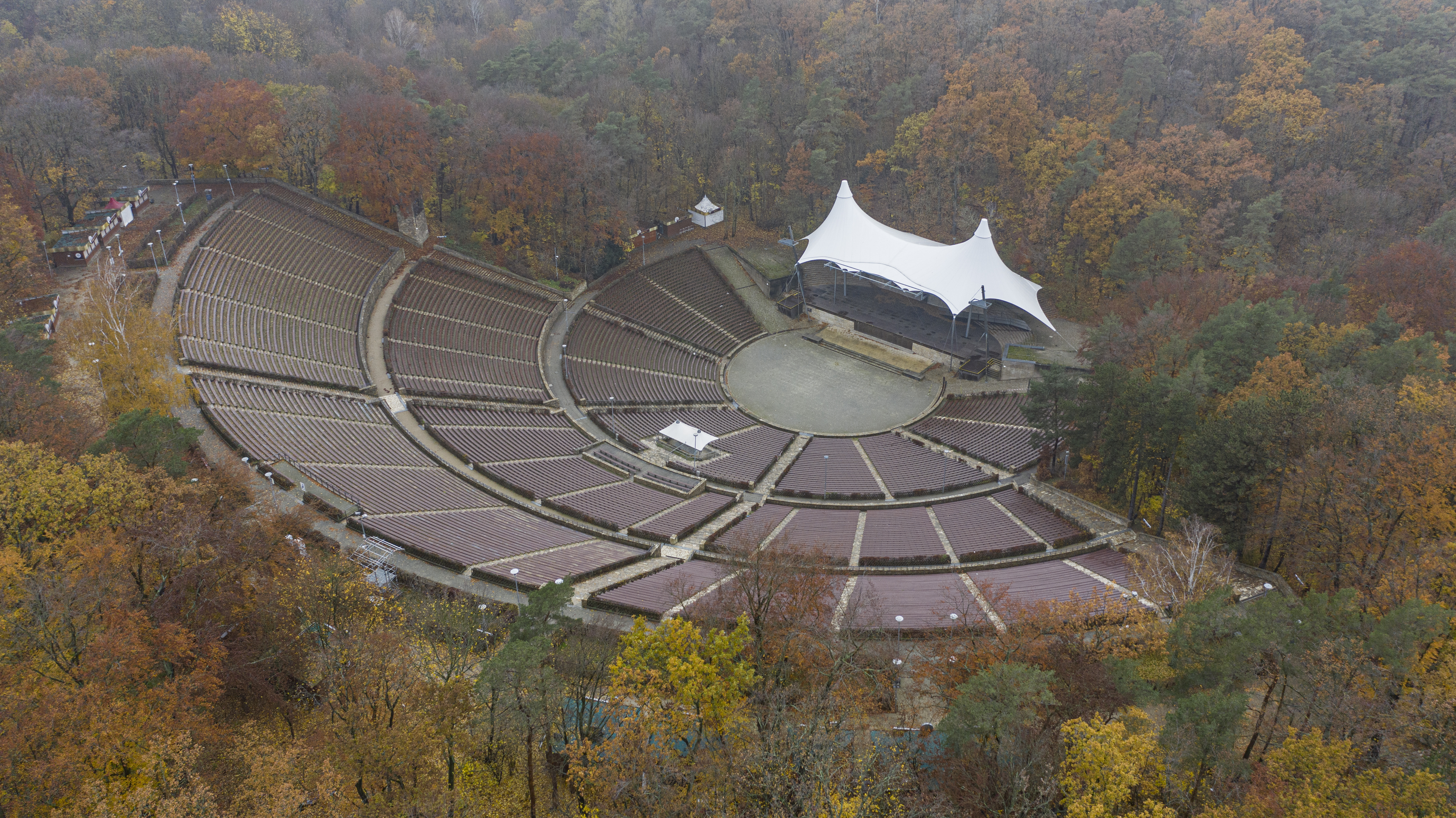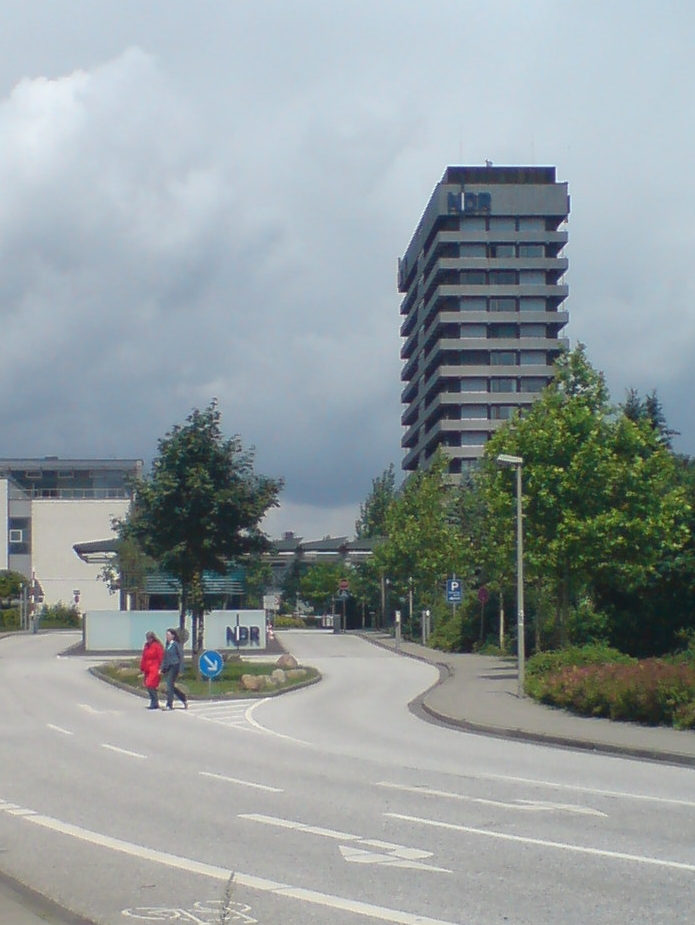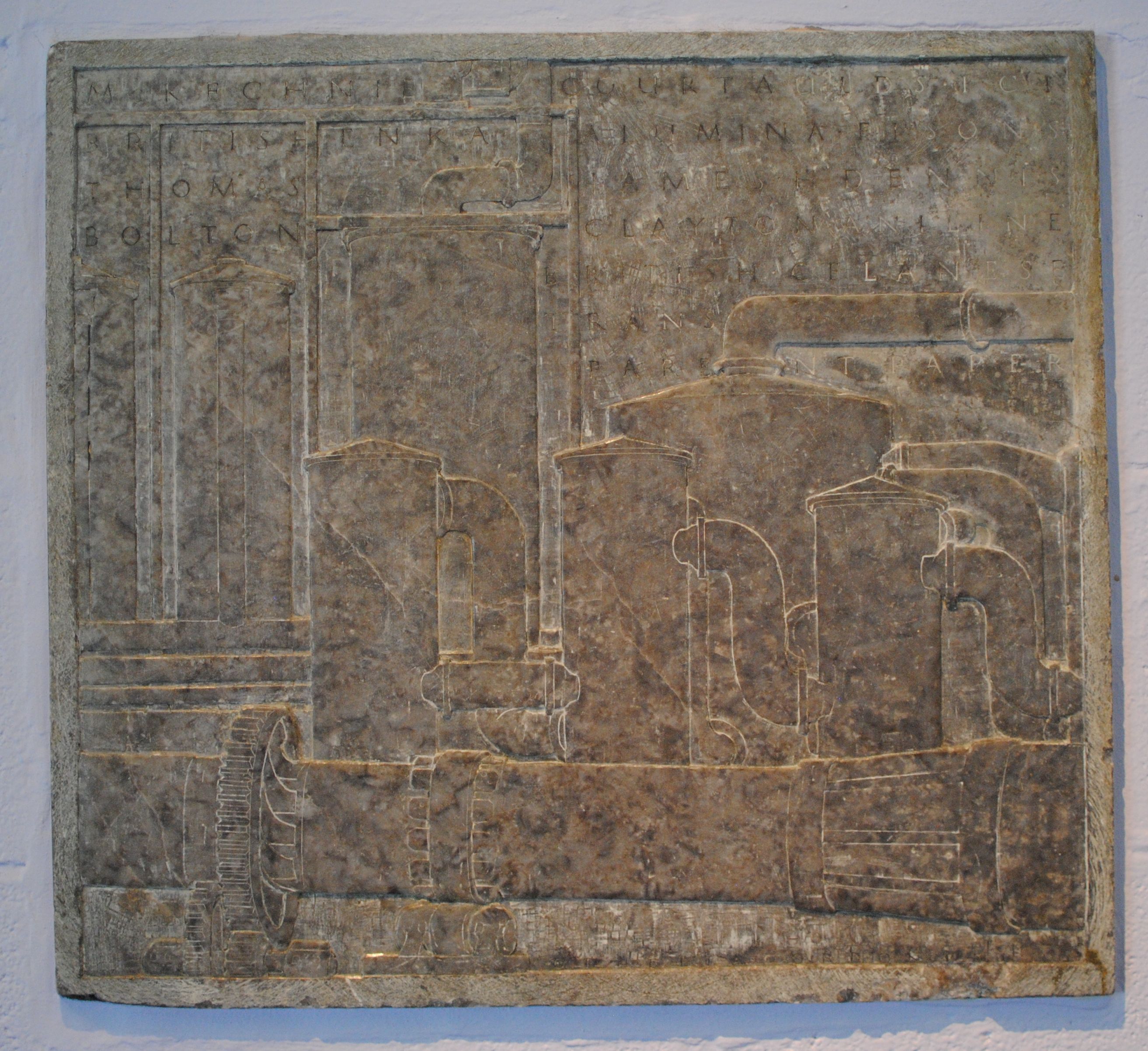|
Bad Segeberg Open-air Theatre
The Kalkberg Stadium (german: Kalkbergstadion) is an open-air theatre built in a former quarry on the Segeberger Kalkberg, a rocky outcropping in the centre of Bad Segeberg, Schleswig-Holstein, Germany. It was built as a Thingplatz under the Third Reich and since 1952 has been the site of the annual Bad Segeberg Karl May Festival. The Kalkberg was mined for salt until 1860 and was the site of a gypsum quarry until 1931. After the Nazis came to power, the quarry was converted into an amphitheatre to be used for mass meetings and multimedia theatrical performances as part of the ''Thingspiel'' movement. The theatre was designed by Fritz Schaller of Berlin, and was constructed mostly by the Reich Labour Service beginning on 29 May 1934. The work entailed sealing salt-mining shafts and cavities and bringing in 1,200 tonnes of granite from Silesia as building material, since the anhydrite core of the hill itself is water-soluble."Kalkbergstadion" aSchleswig-Holstein von A bis Z, Ges ... [...More Info...] [...Related Items...] OR: [Wikipedia] [Google] [Baidu] |
Tonne
The tonne ( or ; symbol: t) is a unit of mass equal to 1000 kilograms. It is a non-SI unit accepted for use with SI. It is also referred to as a metric ton to distinguish it from the non-metric units of the short ton ( United States customary units), and the long ton ( British imperial units). It is equivalent to approximately 2204.6 pounds, 1.102 short tons, and 0.984 long tons. The official SI unit is the megagram (symbol: Mg), a less common way to express the same mass. Symbol and abbreviations The BIPM symbol for the tonne is t, adopted at the same time as the unit in 1879.Table 6 . BIPM. Retrieved on 2011-07-10. Its use is also official for the metric ton in the United States, having been adopted by the United States |
Freilichtbühne Loreley
The Freilichtbühne Loreley (Loreley Open-Air Theatre) is an amphitheatre located on top of the Lorelei rock in St. Goarshausen, Germany. Designed by Hermann Senf, it was built between 1934 and 1939 as one of the Nazi '' Thingplätze'' and is one of the best known of these. It has been used continuously since World War II, initially mainly for theatrical performances and since 1976, mainly for rock concerts. Third Reich The arena was designed by Hermann Senf, who referred to the Loreley rock as a "kind of shrine".Étienne François and Hagen Schulze, eds., ''Deutsche Erinnerungsorte'', Volume 3, Munich: Beck, 2001, p. 497 It is one of the best known of the ''Thingspielplätze'', which were built by the Nazi regime for cultural events. Construction lasted from 1934 to 1939, and the opening took place on 21 June with a performance of Schiller's ''Wilhelm Tell''. [...More Info...] [...Related Items...] OR: [Wikipedia] [Google] [Baidu] |
Waldbühne
The Waldbühne (''Woodland Stage'' or ''Forest Stage'') is a theatre at Olympiapark Berlin in Berlin, Germany. It was designed by German architect Werner March in emulation of a Greek theatre and built between 1934 and 1936 as the Dietrich-Eckart-Freilichtbühne (Dietrich Eckart Open Air Theater), a Nazi Thingplatz, and opened in association with the 1936 Summer Olympics. Since World War II it has been used for a variety of events, including boxing matches, film showings and classical and rock concerts. It seats more than 22,000 people. The venue is located off Friedrich-Friesen-Allee just northeast of Glockenturmstraße. Nazi era The theatre was built as part of the Olympic complex on the request of Propaganda Minister Joseph Goebbels. March made use of a natural ravine and modelled the theatre on ancient Greek amphitheatres. Paul Ortwin Rave and Hinnerk Scheper, eds., rev. Irmgard Wirth, ''Die Bauwerke und Kunstdenkmäler von Berlin: Stadt und Bezirk Charlottenburg'', Volume 1 ... [...More Info...] [...Related Items...] OR: [Wikipedia] [Google] [Baidu] |
Henrik Herse
Henrik is a male given name of Germanic origin, primarily used in Scandinavia, Estonia, Hungary and Slovenia. In Poland, the name is spelt Henryk but pronounced similarly. Equivalents in other languages are Henry (English), Heiki (Estonian), Heikki (Finnish), Henryk (Polish), Hendrik (Dutch), Heinrich (German), Enrico (Italian), Henri (French), Enrique (Spanish) and Henrique (Portuguese). It means 'Ruler of the home' or 'Lord of the house'. People named Henrik include: * Henrik, Prince Consort of Denmark (1934–2018) * Prince Henrik of Denmark (born 2009) * Henrik Agerbeck (born 1956), Danish footballer * Henrik Andersson (badminton) (born 1977), Swedish player * Henrik Christiansen (other) * Henrik Dagård (born 1969), Swedish decathlete * Henrik Dam (1895-1976), Danish biochemist, physiologist and Nobel laureate * Henrik Dettmann (born 1958), Finnish basketball coach * Henrik Otto Donner (1939-2013), Finnish composer and musician * Henrik Fisker (born 1963), Danish ... [...More Info...] [...Related Items...] OR: [Wikipedia] [Google] [Baidu] |
Hamburger Abendblatt
The ''Hamburger Abendblatt'' (English: ''Hamburg Evening Newspaper'') is a German daily newspaper in Hamburg. The paper focuses on news in Hamburg and area, and produces regional supplements with news from Norderstedt, Ahrensburg, Harburg, and Pinneberg. Politically the paper is mildly conservative, but usually pro-government, including during SPD administrations. History and profile Four previous Hamburg newspapers had the word ''Abendblatt'' ("Evening Newspaper") in their title, including one named the ''Hamburger Abendblatt'', founded on 2 May 1820. This incarnation of the ''Hamburger Abendblatt'', however, was first published after World War II beginning on 14 October 1948 with an initial edition of 60,000 copies. The paper received a publishing license from the Hamburg Senate and Mayor Max Brauer, making it the first daily paper of post-war Germany to receive a license from German rather than Allied occupation authorities. After about six months of operation, its ... [...More Info...] [...Related Items...] OR: [Wikipedia] [Google] [Baidu] |
Joseph Goebbels
Paul Joseph Goebbels (; 29 October 1897 – 1 May 1945) was a German Nazi politician who was the ''Gauleiter'' (district leader) of Berlin, chief propagandist for the Nazi Party, and then Reich Minister of Propaganda from 1933 to 1945. He was one of Adolf Hitler's closest and most devoted acolytes, known for his skills in public speaking and his deeply virulent antisemitism, which was evident in his publicly voiced views. He advocated progressively harsher discrimination, including the extermination of the Jews in the Holocaust. Goebbels, who aspired to be an author, obtained a Doctor of Philology degree from the University of Heidelberg in 1921. He joined the Nazi Party in 1924, and worked with Gregor Strasser in its northern branch. He was appointed ''Gauleiter'' of Berlin in 1926, where he began to take an interest in the use of propaganda to promote the party and its programme. After the Nazis came to power in 1933, Goebbels's Propaganda Ministry quickly gained a ... [...More Info...] [...Related Items...] OR: [Wikipedia] [Google] [Baidu] |
Norddeutscher Rundfunk
Norddeutscher Rundfunk (NDR; ''Northern German Broadcasting'') is a public broadcasting, public radio and television broadcaster, based in Hamburg. In addition to the city-state of Hamburg, NDR broadcasts for the German states of Lower Saxony, Mecklenburg-Vorpommern and Schleswig-Holstein. NDR is a member of the ARD (broadcaster), ARD organisation. Studios NDR's studios in Hamburg are in two locations, both within the borough of Eimsbüttel: the television studios are in the quarter of Lokstedt while the radio studios are in the quarter of Harvestehude (though they are called "Funkhaus am Rothenbaum"), a little closer to the city centre. There are also regional studios, having both radio and television production facilities, in the state capitals Hanover, Kiel and Schwerin. The facility in Hanover is now called the Landesfunkhaus Niedersachsen. In addition, NDR maintains facilities at ARD (broadcaster), ARD's national studios in Berlin. Organization and finances Chairmen of the ... [...More Info...] [...Related Items...] OR: [Wikipedia] [Google] [Baidu] |
Anhydrite
Anhydrite, or anhydrous calcium sulfate, is a mineral with the chemical formula CaSO4. It is in the orthorhombic crystal system, with three directions of perfect cleavage parallel to the three planes of symmetry. It is not isomorphous with the orthorhombic barium ( baryte) and strontium ( celestine) sulfates, as might be expected from the chemical formulas. Distinctly developed crystals are somewhat rare, the mineral usually presenting the form of cleavage masses. The Mohs hardness is 3.5, and the specific gravity is 2.9. The color is white, sometimes greyish, bluish, or purple. On the best developed of the three cleavages, the lustre is pearly; on other surfaces it is glassy. When exposed to water, anhydrite readily transforms to the more commonly occurring gypsum, (CaSO4·2H2O) by the absorption of water. This transformation is reversible, with gypsum or calcium sulfate hemihydrate forming anhydrite by heating to around under normal atmospheric conditions. Anhydrite is comm ... [...More Info...] [...Related Items...] OR: [Wikipedia] [Google] [Baidu] |
Silesia
Silesia (, also , ) is a historical region of Central Europe that lies mostly within Poland, with small parts in the Czech Republic and Germany. Its area is approximately , and the population is estimated at around 8,000,000. Silesia is split into two main subregions, Lower Silesia in the west and Upper Silesia in the east. Silesia has a diverse culture, including architecture, costumes, cuisine, traditions, and the Silesian language (minority in Upper Silesia). Silesia is along the Oder River, with the Sudeten Mountains extending across the southern border. The region contains many historical landmarks and UNESCO World Heritage Sites. It is also rich in mineral and natural resources, and includes several important industrial areas. The largest city and Lower Silesia's capital is Wrocław; the historic capital of Upper Silesia is Opole. The biggest metropolitan area is the Upper Silesian metropolitan area, the centre of which is Katowice. Parts of the Czech city of Ostrav ... [...More Info...] [...Related Items...] OR: [Wikipedia] [Google] [Baidu] |
Granite
Granite () is a coarse-grained (phaneritic) intrusive igneous rock composed mostly of quartz, alkali feldspar, and plagioclase. It forms from magma with a high content of silica and alkali metal oxides that slowly cools and solidifies underground. It is common in the continental crust of Earth, where it is found in igneous intrusions. These range in size from dikes only a few centimeters across to batholiths exposed over hundreds of square kilometers. Granite is typical of a larger family of ''granitic rocks'', or ''granitoids'', that are composed mostly of coarse-grained quartz and feldspars in varying proportions. These rocks are classified by the relative percentages of quartz, alkali feldspar, and plagioclase (the QAPF classification), with true granite representing granitic rocks rich in quartz and alkali feldspar. Most granitic rocks also contain mica or amphibole minerals, though a few (known as leucogranites) contain almost no dark minerals. Granite is nearly alway ... [...More Info...] [...Related Items...] OR: [Wikipedia] [Google] [Baidu] |
Reichsarbeitsdienst
The Reich Labour Service (''Reichsarbeitsdienst''; RAD) was a major organisation established in Nazi Germany as an agency to help mitigate the effects of unemployment on the German economy, militarise the workforce and indoctrinate it with Nazi ideology. It was the official state labour service, divided into separate sections for men and women. From June 1935 onward, men aged between 18 and 25 may have served six months before their military service. During World War II, compulsory service also included young women and the RAD developed to an auxiliary formation which provided support for the Wehrmacht armed forces. Foundation In the course of the Great Depression, the German government of the Weimar Republic under Chancellor Heinrich Brüning by emergency decree established the ''Freiwilliger Arbeitsdienst'' ('Voluntary Labour Service', FAD), on 5 June 1931, two years before the Nazi Party (NSDAP) ascended to national power. The state sponsored employment organisation provi ... [...More Info...] [...Related Items...] OR: [Wikipedia] [Google] [Baidu] |






